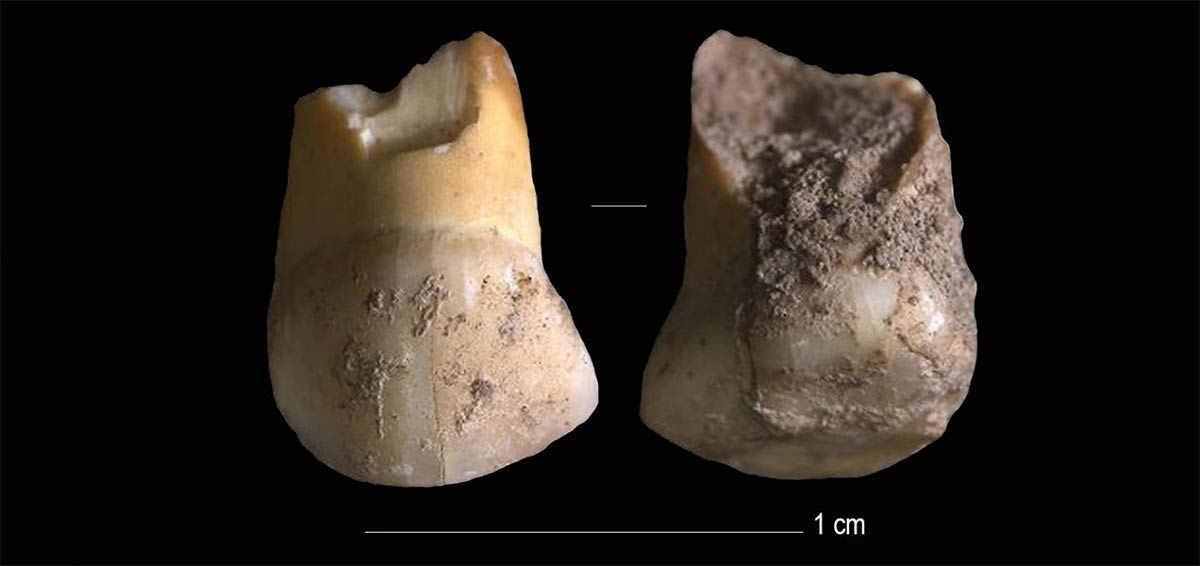The discovery of a milk tooth from a Neanderthal child has been hailed as a major breakthrough. The tiny tooth possibly belonged to one of the last Neanderthals to have lived in Europe and is providing DNA evidence that is helping us to better understand the extinction of the Neanderthals .

The important discovery was made in a rock shelter near Riparo del Broion in the Berici Hills not far from Venice. According to the Journal of Human Evolution , the site “preserves a stratigraphic sequence documenting the Middle-to-Upper Paleolithic transition.” The study was conducted by a team of interdisciplinary experts from the Universities of Ferrara and Bologna. They were working within the framework of the ERC SUCCESS project, which is led by Stefano Benazzi and focuses on the transition of Neanderthals ( Homo neanderthalensis ) to modern humans ( Homo sapiens ) in Italy and the Mediterranean region.

The important discovery was made in a rock shelter near Riparo del Broion in the Berici Hills not far from Venice. The results are still being analyzed, but so far they show that the site was in use for a long time, and there is evidence of Neanderthal hunting activity. ( Journal of Human Evolution )
Finding a Milk Tooth From a 12-Year-Old Neanderthal Child
During the dig, the researchers used some breakthrough archaeological techniques which helped them find the milk tooth. Matteo Romandini, lead author of this study is quoted by Eureka Alert as explaining that they “employed virtual approaches to the analyses of its shape, genome, taphonomy and its radiometric profile. Following this process, we could identify this tooth as belonging to a child that was one of the last Neanderthals in Italy.”
The tooth is a small canine and probably belonged to a 12-year-old child. Some precious DNA was extracted from the tooth and this allowed a genetic analysis to be conducted. The analysis shows that the child probably lived about 47-48,000 years ago. The researchers wrote in the Journal of Human Evolution that the DNA results from the tooth fall “within the known genetic variation of Late Pleistocene Neanderthals.”

Neanderthal footprint found in Gibraltar. Archaeologists are forever on a quest to discover more about our Neanderthal cousins and to understand why they became extinct. ( University of Seville / ScienceDaily )
Who Did the Tooth Belong To?
Eureka Alert reports that this find “makes this site in Veneto a key-area for comprehending the gradual extinction of Neanderthals in Europe.” It was soon established that the mother of the child was descended from Neanderthals who had lived in modern-day Belgium. This may indicate that these species or subspecies of early humans migrated great distances , possibly in search of food.
Analysis of the tooth is helping researchers to understand the lost world of the Neanderthals. Gregorio Oxilia and Eugenio Bortolini, of the University of Bologna, told Eureka Alert : “According to this dating, this little milk-tooth is the most recent finding of the Neanderthal period in Northern Italy and one of the latest in the entire peninsula.” This means that the tooth probably belonged to one of the last Neanderthal communities in Europe.
The Mysterious Extinction of the Neanderthals
These archaic humans were very sophisticated: Neanderthals even developed cultural practices, such as art and the burial of the dead. Their remains have been found over much of Eurasia, over an era spanning thousands of years. However, about 48,000 years ago modern humans began to enter Eurasia. At about the same time the Neanderthal populations began to decline, and it is believed that they were outcompeted by Homo sapiens. However, it has also been theorized that they died out because of diseases brought by modern humans or that they were even exterminated by our ancestors. It is believed that “the two species managed to co-exist for around 8,000 years,” reports the Daily Mail .
Whatever the reasons, the Neanderthals were completely replaced in Europe by anatomically modern humans. When exactly the Neanderthals completely died out is unknown, though one of their last bands is believed to have lived in Gibraltar about 42,000 years ago. Though, let’s not forget that they did not totally disappear. Neanderthals interbred with our ancestors and as a result all modern humans have a small percentage of Neanderthal DNA.
 All About Neanderthals – The Surprising Facts
All About Neanderthals – The Surprising Facts Top Ten Myths about Neanderthals
Top Ten Myths about Neanderthals Oldest Ever Neanderthal Remains Found, Dating Back 116,000 Years!
Oldest Ever Neanderthal Remains Found, Dating Back 116,000 Years!
This incredibly rare find is still being analyzed and the researchers believe the tooth may reveal more secrets about the Neanderthal child and her community. Investigations at the site are ongoing and many tools have been found which serve as signs of hunting and the processing of animals for food and hides. Marco Peresanti, one of the study’s contributors, is quoted by the Daily Mail as saying that the “manufacturing of tools, mainly made of flint, shows Neanderthals’ great adaptability and their systematic and specialized exploitation of the raw materials available in this area.” The finds of tools are proof that the Neanderthals were not primitive caveman, as it is believed in popular imagination. This site may also help to provide information that could help researchers understand some of the last Neanderthals in Europe and why they became extinct.
Top image: The discovery of an upper canine milk tooth that belonged to a Neanderthal child, aged 11 or 12, is believed to be about 48,000 years old. The discovery could help understand some of the last Neanderthals in Europe and why they became extinct. Source: Journal of Human Evolution .
Sources:ancient-origins.net








